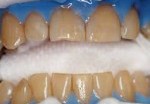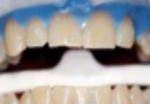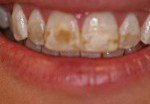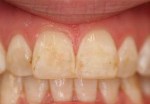Teeth Whitening: How Belle Dental Does it

Teeth whitening, although it has recently gained popularity, has been available for over 20 years. The techniques and materials have been refined to improve results. Essentially, teeth whitening involves the placement of a peroxide against the tooth surface. The peroxide is absorbed by the tooth. The peroxide molecules interact with stains present in the tooth, resulting in the breaking down and liberation of stains in the tooth.
For best results the teeth should be professionally cleaned and polished prior to commencement of any bleaching therapies.
Essentially there are 2 main forms of teeth whitening in use:
1) Home Whitening – this is the application of a peroxide gel to the teeth using custom formed splints that accurately fit against upper and lower teeth. The peroxide gel may be applied during sleep, once a day for a set period (during the day) or twice a day for a set period – depending on the system used.
2) In-Office Whitening – this technique involves the carefully controlled application of bleaching agents to the teeth in a surgery setting, followed by a short period of home whitening – usually 3-4 days.
- Before
- After
The results from both in-office and home whitening is exactly the same… the only difference being the amount of effort required once you leave the office.
Note: Belle Dental advises all patients to cease smoking during the teeth whitening process.
Factors that apply to Teeth Whitening
Coloured food, drink and inhalants
Any coloured substance that you eat, drink or inhale orally stains your teeth. If it can stain a white shirt, it can stain your teeth. The duration of contact, frequency of contact and intensity of colour all affect the degree to which coloured substances stain out teeth.
Coloured food substances include:
| Tea | Coffee | Cola Drinks |
| Soy Sauce | Coloured Pasta Sauces | Artichokes |
| Spinach | Cigarettes | Black currant juice |
| Beetroot | Some Asthma Inhalers | Red Wine! |
The balance of this is that we are here on earth to enjoy ourselves. I am not suggesting to abstain from medications – I am merely pointing out some of the substances that stain teeth.
Use of Whitening Toothpastes and Over the Counter Whitening Kits
Use of whitening toothpastes and over the counter whitening kits, in our experience, does not have a significant whitening effect on teeth. However, it appears that whitening toothpastes do have a protective effect against staining i.e. if you use a whitening toothpaste, the rate at which your teeth will discolour will be significantly slowed.
Tetracycline Staining
Tetracyclines are a form of antibiotic that can cause significant tooth staining. If tetracyclines are administered at the time of tooth formation (ages 1 ½ – 12 years), these antibiotics can be incorporated into the forming tooth structure resulting in a greyish / brownish staining that can vary in intensity from very mild right up to quite severe dark brown staining. Our experience has been that this type of staining, generally, responds poorly to any form of teeth whitening . Tooth whitening with this type of staining needs to be approached on a case by case basis.
Flurosis
Flurosis is the mottled brown and opaque white staining we see on teeth associated with larger doses of fluoride during the formative stages of the teeth. Some patients are concerned about the appearance of flurosis but from a functional perspective, these teeth are actually more resistant to decay than teeth that do not exhibit this characteristic.
- Before
- After
How to treat Flurosis – If flurosis is a cosmetic concern to you, it is possible to treat this condition of the teeth and achieve partial or often complete reversion to normal tooth. Please call us if this concerns you as there are a number of conservative options.
How to get started on Whitening?
So that we may best advise you regarding your whitening options, it is best to make an appointment for an examination and a clean. Your teeth should be cleaned before commencement of tooth whitening – we can also take impressions at this appointment so you can get straight onto your whitening – next visit. Whitening should form a part of your comprehensive treatment plan.








